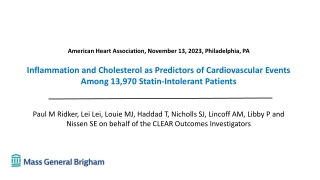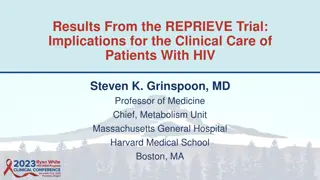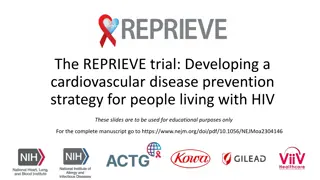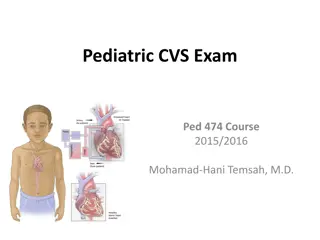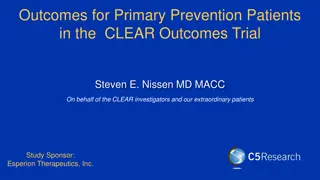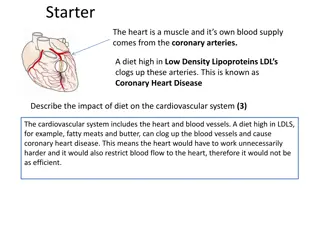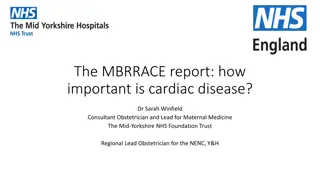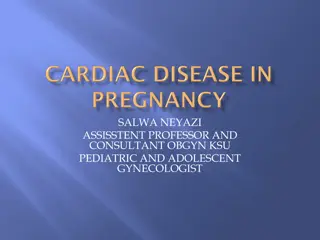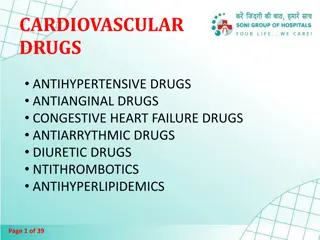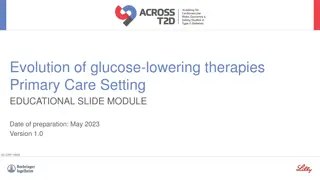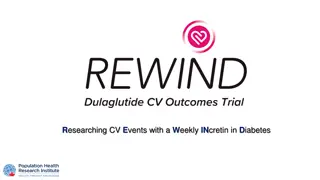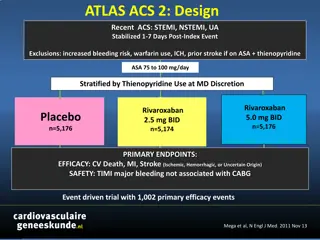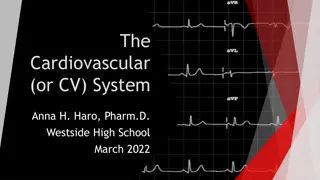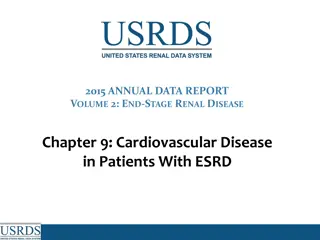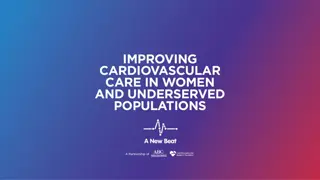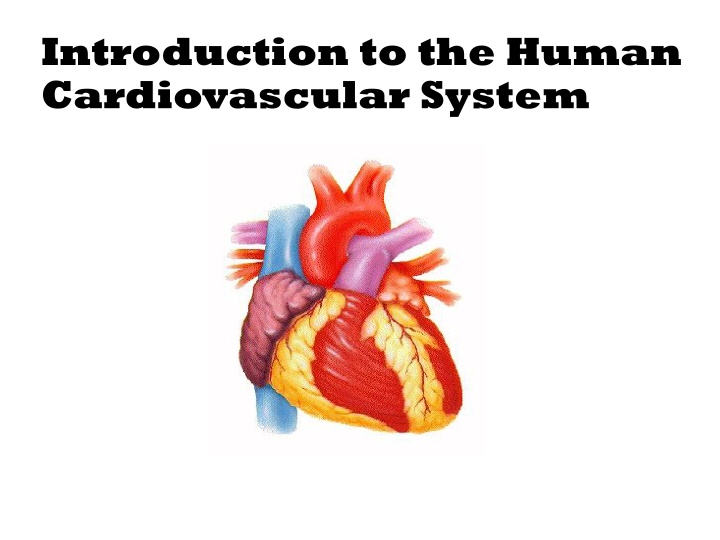
The Human Cardiovascular System
Explore the intricate workings of the human cardiovascular system, consisting of the heart, blood, and blood vessels. Learn about its functions, components, and the crucial role it plays in transporting nutrients, removing waste products, gaseous exchange, immunity, and more. Delve into the fascinating world of blood cells, plasma, the heart's four-chambered structure, and the essential functions it performs in regulating blood pressure and flow. Discover the network of blood vessels including arteries, capillaries, and veins that form a closed system essential for circulation throughout the body.
Download Presentation

Please find below an Image/Link to download the presentation.
The content on the website is provided AS IS for your information and personal use only. It may not be sold, licensed, or shared on other websites without obtaining consent from the author. If you encounter any issues during the download, it is possible that the publisher has removed the file from their server.
You are allowed to download the files provided on this website for personal or commercial use, subject to the condition that they are used lawfully. All files are the property of their respective owners.
The content on the website is provided AS IS for your information and personal use only. It may not be sold, licensed, or shared on other websites without obtaining consent from the author.
E N D
Presentation Transcript
Introduction to the Human Cardiovascular System
INTRODUCTION INTRODUCTION The cardiovascular system is transport system of body It comprises blood, heart and blood vessels. The system supplies nutrients to and remove products from various tissue of body. The conveying media is liquid in form of blood which flows in close tubular system. waste Figure 1-2(f)
FUNCTION OF CARDIOVASCULAR SYSTEM FUNCTION OF CARDIOVASCULAR SYSTEM Transport nutrients, hormones Remove waste products Gaseous exchange Immunity Blood vessels transport blood Carries oxygen and carbon dioxide Also carries nutrients and wastes Heart pumps blood through blood vessels
COMPONENTS OF CARDIOVASCULAR COMPONENTS OF CARDIOVASCULAR SYSTEM SYSTEM BLOOD HEART BLOOD VESSELS
BLOOD BLOOD The Blood: Blood cells & Plasma Blood cells 1- Erythrocytes - Red Blood Cells 2- Leucocytes 3- Thrombocytes Plasma is fluid portion
HEART HEART Heart is a four chambered, hollow muscular organ approximately the size of your fist Location: Superior surface of diaphragm Left of the midline Anterior to the vertebral column, posterior to the sternum Chapter 18, Cardiovascular System 6
HEART HEART Figure 18.1 Chapter 18, Cardiovascular System 7
FUNCTIONS OF THE HEART FUNCTIONS OF THE HEART Generating blood pressure Routing blood Heart separates pulmonary and systemic circulations Ensuring one-way blood flow Heart valves ensure one-way flow Regulating blood supply Changes in contraction rate and force match blood delivery to changing metabolic needs
BLOOD VESSELS BLOOD VESSELS Blood Vessels -A closed network of tubes These includes: Arteries Capillaries Veins
BLOOD VESSELS BLOOD VESSELS -Arteries(Distributing channel) Thick walled tubes Elastic Fibers Circular Smooth Muscle Capillaries (microscopic vessels) One cell thick Serves the Respiratory System Veins (draining channel)
BLOOD VESSELS BLOOD VESSELS General structure 1.Tunica intima 2.Tunica media 3.Tunica adventitia
CLASSIFICATION OF BLOOD VESSELS CLASSIFICATION OF BLOOD VESSELS Conducting Vessels Distributing Vessels Resistance Vessels Exchange Vessels Capacitance / Reservoir Vessels
ARTERIES ARTERIES Blood carry blood away from the heart are called arteries. They are the thickest blood vessels and they carry blood high in oxygen known oxygenated (oxygen rich blood). vessels that as blood
ARTERIES ARTERIES Accompanied by vein and nerves Lumen is small No valves Repeated branching
CLASSIFICATION OF ARTEIES CLASSIFICATION OF ARTEIES Elastic- e.g. (Aorta & its Major branches) Muscular -e.g.(Renal, Testicular, Radial, Tibial etc.) Arterioles (<0.1 mm)- Terminal arterioles Meta-arterioles Thoroughfare channel/ preferred
CAPILLARIES CAPILLARIES (5 (5- -8 micron) 8 micron) The smallest blood vessels are capillaries and they connect the arteries and veins. This is where the exchange of nutrients and gases occurs.
BODY CONTAINS TWO KINDS OF CAPILLARIES CONTINUOUS-SKIN, LUNG, SMMOTH MUSCLE, CONNECTIVE TISSUES FENESTRATED- PANCREAS,ENDOCRINE GLANDS, SMALL INTESTINE,CHOROID PLEXUS,CILLIARY PROCESS etc.
SINUSOIDS SINUSOIDS SINUSOIDS- Large irregular vascular space (30-40 micron) eg.Liver, Spleen, Bone marrow, suprarenal, Parathyroid etc.
VEINS VEINS Blood vessels that carry blood back to the heart are called veins. They have one-way valves which prevent blood from flowing backwards. They carry blood that is high in carbon dioxide known as deoxygenated blood (oxygen blood). poor
VEINS VEINS Thin Walled Large irregular lumen Have valves Dead space around Types: Large Medium Small
VEINS VEINS Veins without valves: SVC & IVC Hepatic, Renal Uterine, Ovarian not Testicular Facial Pulmonary Umbilical Emissary Portal Veins <2mm
VEINS VEINS Veins without Muscular tissue: Dural venous sinuses Pial Veins Retinal Veins of erectile tissue of sex organs Veins of spongy bones
VEINS VEINS Factors responsible for venous return: 1.Muscle contraction 2.Negative intrathoracic pressure 3.Pulsation of arteries 4. Gravity 5. Valves
ANASTOMOSIS ANASTOMOSIS Communication between vessels ARTERIAL: Actual( end to end & convergent)-Palmar, plantar, Willis, Labial Intestinal arcade, etc. Potential-Coronary, around joints etc. Circle of
ANASTOMOSIS ANASTOMOSIS ARTERIOVENOUS ANASTOMOSIS: 1.Skin of nose 2. Lips 3. External Ear 4. Mucus membrane of GI & nose 5. Erectile tissue of sex organ 6. Thyroid 7. Tongue
END ARTERIES END ARTERIES END ARTERIES: 1.Central artery of retina 2. Arteries of spleen, liver, kidneys, metaphyses of long bones 3. Central branches of cerebral cortex
CIRCULATION CIRCULATION Coronary circulation the circulation of blood within the heart. Pulmonary circulation the flow of blood between the heart and lungs. Systemic circulation the flow of blood between the heart and the cells of the body. Fetal Circulation
SYSTEMIC AND PULMONARY CIRCULATION SYSTEMIC AND PULMONARY CIRCULATION Pulmonary circulation The flow of blood between the heart and lungs. Systemic The flow of blood between the heart and the cells of the body. circulation Figure 18.5 Chapter 18, Cardiovascular System 29
CORONARY CIRCULATION: ARTERIAL SUPPLY CORONARY CIRCULATION: ARTERIAL SUPPLY Chapter 18, Cardiovascular System 30 Figure 18.7a
PORTAL CIRCULATION PORTAL CIRCULATION Portal circulation - the flow of blood between tow set of capillaries draining in systemic veins. before
FETAL CIRCULATION FETAL CIRCULATION
PLACENTA UMBILICAL ARTERY UMBILICAL VEIN DESCENDING AORTA (Through Ductus Arteriosus) PORTAL VEIN (Through Ductus Venosus) INFERIOR VENA CAVA PULMONARY TRUNK RIFHT ATRIUM (Through Foramen Ovale) RIGHT VENTRICLE ASCENDING AORTA LEFT ATRIUM
APPLIED APPLIED Diseases and Disorders BLOOD PRESSURE HAEMORRHAGE/STROKE ARTERIOSCLEROSIS ANEURYSM CORONARY ARTERY DISEASE (CAD) HEART ATTACK CONGESTIVE HEART FAILURE (CHF) ANEMIA, HEMOPHILIA, AND LEUKEMIA
APPLIED APPLIED Problems with the cardiovascular system are common, but they don t just affect older people. Many heart problems affect children and teenagers.
THANK YOU THANK YOU

